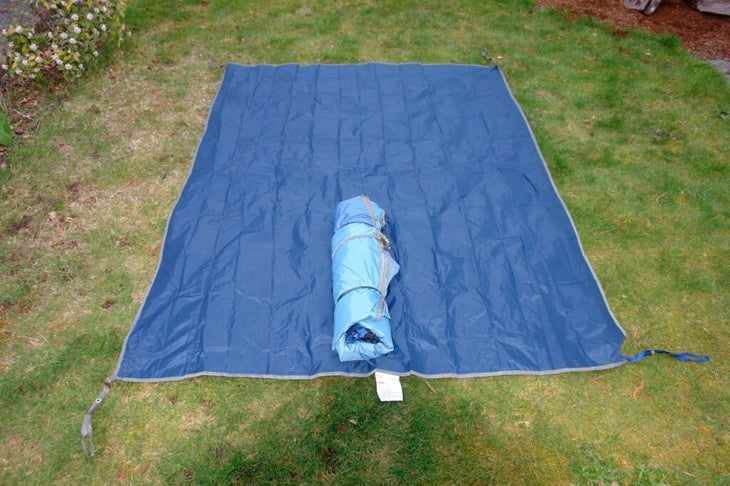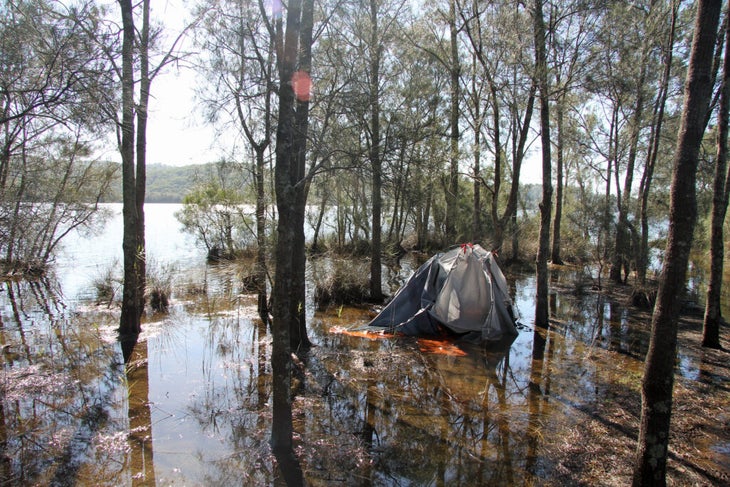This is the One Piece of Backpacking Gear No One Really Needs

I learned to backpack from a handful of Boy Scout dropouts. This was in college, a time when many of my peers had very strong opinions about the right way to do everything and very little actual experience to back it up. New to backpacking but very anxious to appear just as smart as everybody else, I quickly started parroting all these “right opinions” back to anyone who asked. So, when one of my friends told me that tent footprints are an absolute must-have gear item, I nodded solemnly and accepted this fact as gospel. I did not stop to ask any of the questions I was left with. Namely: “Why should I have to spend yet another $50 on this thing I don’t understand,” “How come John never uses one and he’s just fine,” and “What is a tent footprint, anyway?”
The longer I’ve been a backpacker, the more I’ve realized that there’s no one right way to do things—including setting up your tent. Here’s what you really need to know.

What is a tent footprint?
A tent footprint—sometimes called a tent groundsheet or groundcloth—is basically a tarp cut in the shape of your tent floor. You lay it beneath your tent to protect your tent floor from punctures. A groundsheet also provides an additional layer of waterproofing, which can keep water from seeping in through your tent floor if the built-in waterproofing is compromised.
Footprints are generally sized to be slightly smaller than the actual dimensions of your tent. That way when it rains, water will run down the sides of your tent or fly and straight into the ground. If your groundsheet extends beyond the edge of your tent, it will catch water and funnel it underneath you while you sleep. That drastically raises your odds of waking in a puddle.
Similar Reads
While you can make your own groundcloth out of Tyvek or another waterproof material for very little money, most commercial tent footprints cost anywhere from $20 to $120. Most land right in the middle, around $50, and weigh 8 to 10 ounces on average.
Do you really need one?
This brings us to our next question: What is a tent footprint really good for, anyway? In my (somewhat controversial) opinion: not much. Diehards will tell you that a good groundsheet will keep your tent from taking on holes, which are surprisingly easy to acquire from pinecones, sticks, and sharp rocks. While many footprints cost $50 to $100, some can cost up to $180 if you’re using space-age materials or have a funky-shaped tent and need to order yours custom from the brand. That’s not nothing, but it’s still cheaper to replace than an entire tent.
This is all true. But you know what’s also easier to do than replacing a tent? Patching a tent. I never use a footprint—not when I’m camping on rocky ground, not when I’m in pinecone country, and not when I’m using my extra special, very favorite ultralight tent. Instead, I carry a patch kit. And I save my $100 for my post-camp hamburger-and-beer run.
The other issue with footprints is that, while they can, in theory, provide a little extra protection against wet weather, they don’t really. If it’s raining a little bit, fine—your tent floor is already designed to be very waterproof. And if it’s raining a lot? The puddles are going to find you anyway. Carrying a footprint just means you’ll have a whole extra piece of wet, heavy gear to carry and, later, dry.
That said, there are a few occasions where carrying a footprint might be worth it for you.

When to use a tent footprint
If you’re using an extremely expensive tent and/or aren’t confident in your ability to patch your floor in the field, it may be worth it for you to carry a footprint. The same is true if you are tarp camping (i.e. sleeping in a tent that does not have a floor. I’d also recommend packing a footprint if you plan to carry an emergency tarp anyway. In that case, the footprint can do double-duty.
Here are a few of the other pros and cons to consider.
Pros
- Slight boost in protection against wet or uneven ground
- Slight boost in insulation from cold or snowy ground
- Can improve tent longevity
- Can be used as a tarp in a pinch
Cons
- Extra weight
- Extra bulk in your pack
- Often expensive
- Useless in many terrain types
- Adds time and effort to tent setup
- Can funnel water beneath tent if used incorrectly


